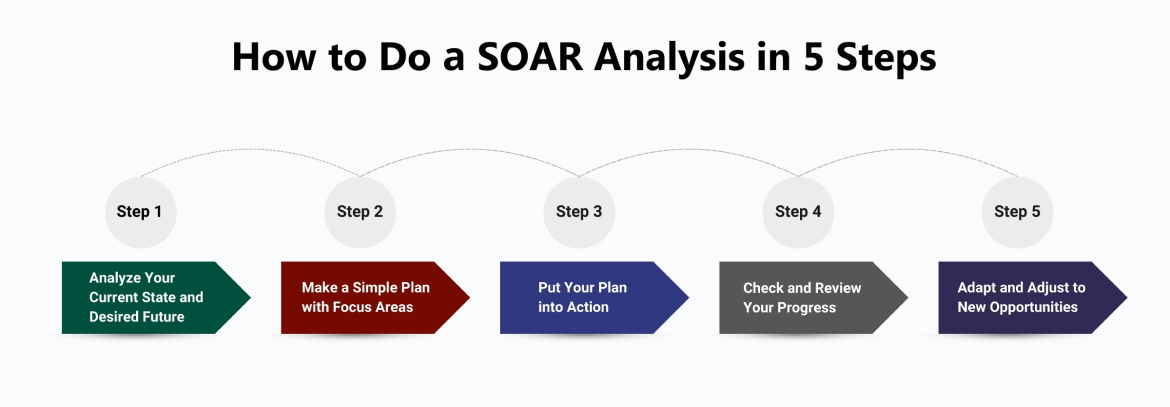Companies need tools that focus on what’s going well instead of just fixing problems. A SOAR analysis is a helpful planning tool that uses a company’s strengths to plan a bright future. This simple method matches today’s successes with new chances and goals, making it great for creating a shared vision. This article explains what SOAR analysis is, how it works, and how to use it step-by-step to improve your strategy.
A SOAR analysis framework stands for Strengths, Opportunities, Aspirations, and Results. It’s a planning tool that helps organizations look at what they’re good at now and what they can do in the future using a 2x2 chart. This tool builds a positive, forward-looking plan that shows the company’s special qualities and links today with tomorrow’s dreams.
Unlike other tools that focus on weaknesses, SOAR analysis builds on what’s working. The top part of the chart shows the present (Strengths and Opportunities), while the bottom part looks at the future (Aspirations and Results). The left side covers things inside the company, and the right side looks at outside factors. This makes it a practical way to shape your strategy and turn ideas into action.
The SOAR analysis chart is easy to follow and splits into four parts:
This setup makes SOAR analysis a useful tool for bringing your team together and pushing growth.
Here’s a simple guide to get started:

Start with a meeting with coworkers and stakeholders. Use the top part (Strengths and Opportunities) to list what’s happening now, like good customer relationships, market growth, or nice feedback. Then, fill the bottom part (Aspirations and Results) with future goals, like hitting specific targets or entering new markets. Add lots of details to make your plan strong. Include employees, bosses, and even customers for different ideas. This teamwork builds a shared vision and gets everyone involved.
Brainstorming can bring up many ideas, so pick the best ones to focus on. Choose goals that are doable and make a big difference to connect now with your future. Use easy planning tools to organize these into a clear plan. Pick a few big wins instead of spreading out too thin. This keeps your planning tool practical and effective.
Turning plans into action is where it counts. Just sending a note won’t work, employees need to feel part of it. Without their support, they might stick to old ways, causing confusion and low energy. Share clearly by setting goals, giving tasks to people, and having check-in meetings. Use tools that link teams and show openness. This builds a culture of responsibility, lifting performance and happiness.
A SOAR analysis framework isn’t a one-time thing, it’s an ongoing process. After setting your plan, track how you’re doing against your targets. Without regular checks, it’s easy to fall back into old habits and miss goals. Use simple dashboards or software to watch goals and objectives. Catching problems early lets you fix them before they stop your plan. Regular reviews keep your team on track and ready to share wins with leaders.
Markets shift, and your SOAR analysis should too. What works today might not tomorrow. As your company grows, update the chart to match new trends or changes inside. This flexibility keeps your planning tool fresh. Adjusting helps you grab new opportunities and tweak goals, keeping your strategy in line with the future.
SOAR analysis has good points:
But it has downsides:
Pick SOAR analysis based on what you need. It’s best for companies focused on growth and new ideas, not those dealing with big risks. A SWOT analysis is better for spotting threats. Use SOAR for inside discovery and future planning, not checking competitors.
Try it when you want a hopeful view of your strategy, especially for team agreement and goal-setting.
Both are planning tools, but they’re different:
See how SOAR analysis works for real businesses:
These examples show how SOAR turns strengths into measurable wins.
To make the most of SOAR analysis:
SOAR analysis is a flexible planning tool that builds on strengths and chances to create a future-ready strategy. Unlike SWOT, it skips weaknesses to focus on growth, using simple goals and objectives to track progress. By following the five steps, looking at now, planning, acting, reviewing, and adjusting, companies can turn ideas into results. Whether for HR, new ideas, or team unity, SOAR analysis offers a positive way to succeed. Start using it today to lead your organization to a bright future.

CredBadge™ is a proprietary, secure, digital badging platform that provides for seamless authentication and verification of credentials across digital media worldwide.
CredBadge™ powered credentials ensure that professionals can showcase and verify their qualifications and credentials across all digital platforms, and at any time, across the planet.

Keep yourself informed on the latest updates and information about business strategy by subscribing to our newsletter.